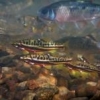I currently have semi-native aquariums because my fish are natives but my plants are non-natives (South American species). In an effort to create truly native aquariums I'm looking for ideas from experienced aquarists on species (found in U.S.) that can be easily obtained but aren't listed on the federal or North Carolina invasive or noxious weeds lists.
Even though my education background is in Plant and Soil Sciences, my knowledge of aquatic species is minimal, so all experienced advice is welcome.
Edited by Freshwater13, 15 February 2015 - 11:26 AM.










